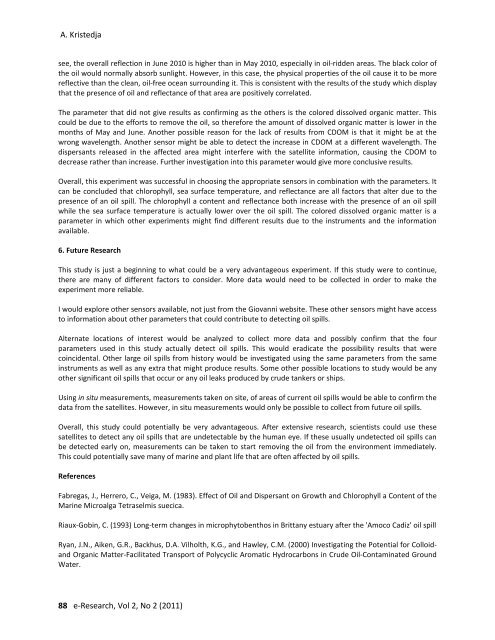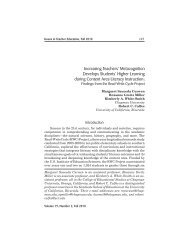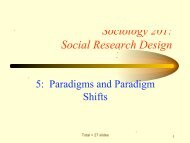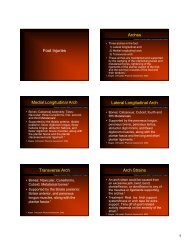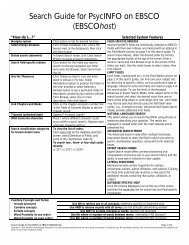e-Research: A Journal of Undergraduate Work - Chapman University
e-Research: A Journal of Undergraduate Work - Chapman University
e-Research: A Journal of Undergraduate Work - Chapman University
Create successful ePaper yourself
Turn your PDF publications into a flip-book with our unique Google optimized e-Paper software.
A. Kristedja<br />
see, the overall reflection in June 2010 is higher than in May 2010, especially in oil-ridden areas. The black color <strong>of</strong><br />
the oil would normally absorb sunlight. However, in this case, the physical properties <strong>of</strong> the oil cause it to be more<br />
reflective than the clean, oil-free ocean surrounding it. This is consistent with the results <strong>of</strong> the study which display<br />
that the presence <strong>of</strong> oil and reflectance <strong>of</strong> that area are positively correlated.<br />
The parameter that did not give results as confirming as the others is the colored dissolved organic matter. This<br />
could be due to the efforts to remove the oil, so therefore the amount <strong>of</strong> dissolved organic matter is lower in the<br />
months <strong>of</strong> May and June. Another possible reason for the lack <strong>of</strong> results from CDOM is that it might be at the<br />
wrong wavelength. Another sensor might be able to detect the increase in CDOM at a different wavelength. The<br />
dispersants released in the affected area might interfere with the satellite information, causing the CDOM to<br />
decrease rather than increase. Further investigation into this parameter would give more conclusive results.<br />
Overall, this experiment was successful in choosing the appropriate sensors in combination with the parameters. It<br />
can be concluded that chlorophyll, sea surface temperature, and reflectance are all factors that alter due to the<br />
presence <strong>of</strong> an oil spill. The chlorophyll a content and reflectance both increase with the presence <strong>of</strong> an oil spill<br />
while the sea surface temperature is actually lower over the oil spill. The colored dissolved organic matter is a<br />
parameter in which other experiments might find different results due to the instruments and the information<br />
available.<br />
6. Future <strong>Research</strong><br />
This study is just a beginning to what could be a very advantageous experiment. If this study were to continue,<br />
there are many <strong>of</strong> different factors to consider. More data would need to be collected in order to make the<br />
experiment more reliable.<br />
I would explore other sensors available, not just from the Giovanni website. These other sensors might have access<br />
to information about other parameters that could contribute to detecting oil spills.<br />
Alternate locations <strong>of</strong> interest would be analyzed to collect more data and possibly confirm that the four<br />
parameters used in this study actually detect oil spills. This would eradicate the possibility results that were<br />
coincidental. Other large oil spills from history would be investigated using the same parameters from the same<br />
instruments as well as any extra that might produce results. Some other possible locations to study would be any<br />
other significant oil spills that occur or any oil leaks produced by crude tankers or ships.<br />
Using in situ measurements, measurements taken on site, <strong>of</strong> areas <strong>of</strong> current oil spills would be able to confirm the<br />
data from the satellites. However, in situ measurements would only be possible to collect from future oil spills.<br />
Overall, this study could potentially be very advantageous. After extensive research, scientists could use these<br />
satellites to detect any oil spills that are undetectable by the human eye. If these usually undetected oil spills can<br />
be detected early on, measurements can be taken to start removing the oil from the environment immediately.<br />
This could potentially save many <strong>of</strong> marine and plant life that are <strong>of</strong>ten affected by oil spills.<br />
References<br />
Fabregas, J., Herrero, C., Veiga, M. (1983). Effect <strong>of</strong> Oil and Dispersant on Growth and Chlorophyll a Content <strong>of</strong> the<br />
Marine Microalga Tetraselmis suecica.<br />
Riaux-Gobin, C. (1993) Long-term changes in microphytobenthos in Brittany estuary after the 'Amoco Cadiz' oil spill<br />
Ryan, J.N., Aiken, G.R., Backhus, D.A. Vilholth, K.G., and Hawley, C.M. (2000) Investigating the Potential for Colloid-<br />
and Organic Matter-Facilitated Transport <strong>of</strong> Polycyclic Aromatic Hydrocarbons in Crude Oil-Contaminated Ground<br />
Water.<br />
88 e-<strong>Research</strong>, Vol 2, No 2 (2011)


